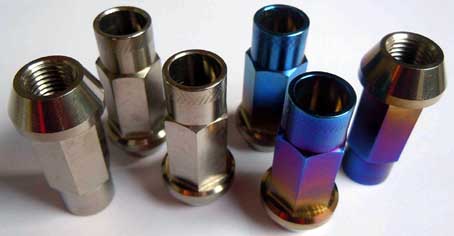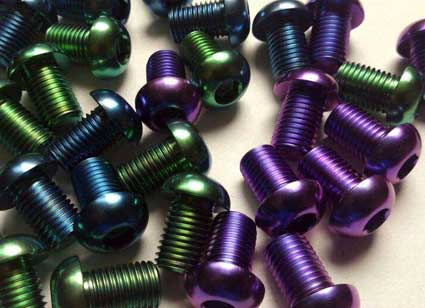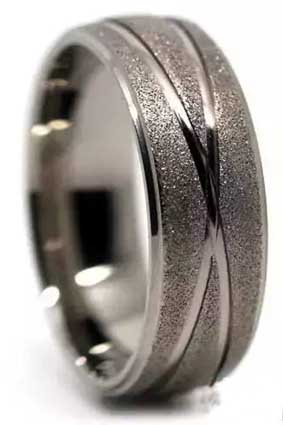Surface Modification and Surface Color Treatment of Titanium and Titanium Alloys
Key words: Titanium alloy surface treatment, nitriding, anodizing, atmospheric oxidation, coloring, surface coarsening, Sandblasting, Pickling
1. Nitriding:
Chemical heat treatment techniques such as plasma nitriding, multi-arc ion plating, ion implantation, and laser nitriding are employed. A golden yellow TiN plating layer is formed on the surface of the titanium denture to improve the wear resistance, corrosion resistance and fatigue resistance of the titanium. However, the technology is complicated and the equipment is expensive. It is difficult to achieve clinical application for surface modification of titanium dentures.

2. Anodizing of titanium alloys:
The anodizing technique of titanium is relatively easy. In some oxidizing media, under the action of applied voltage, the titanium anode can form a thicker oxide film, thus improving its corrosion resistance, wear resistance and weather resistance. The anodized electrolyte generally uses H2SO4, H3PO4 and an aqueous organic acid solution.
3. Atmospheric oxidation: Titanium can form a thick and strong anhydrous oxide film in high temperature atmosphere, which is effective for comprehensive corrosion and crevice corrosion of titanium. The method is relatively simple.
4. Coloring
In order to increase the aesthetics of titanium dentures, prevent the discoloration of titanium dentures under natural conditions. The surface nitriding treatment, atmospheric oxidation and anodic oxidation surface coloring treatment, the surface formation of pale yellow or golden yellow, improve the beauty of titanium denture. The anodizing method utilizes the interference effect of the oxide film of titanium on light, and naturally develops color, and can form a colorful color on the surface of the titanium by changing the cell voltage.
5. Surface roughening:
In order to improve the bonding property between titanium and the facing resin, it is necessary to roughen the surface of the titanium to increase the bonding area. Sandblasting roughening is often used clinically, but sandblasting can cause alumina contamination on the titanium surface. We use oxalic acid etching to obtain a good roughening effect. The surface roughness (Ra) after etching for 1h can reach 1.50±0.30μm, and the etching is 2h Ra is 2.99±0.57μm. It is more than doubled than Ra (1.42±0.14μm) for sand blasting alone, and its bond strength is increased by 30%.

6: High temperature oxidation resistant surface treatment:
In order to prevent the rapid oxidation of titanium at a high temperature, a titanium silicon compound and a titanium aluminum compound are formed on the surface of titanium to prevent oxidation of titanium at a temperature of 700 ° C or higher. This surface treatment is very effective for the high temperature oxidation of titanium. Perhaps the coating of such compounds on the surface of titanium is beneficial to the combination of titanium and porcelain, and further research is needed.
7. Sandblasting:
The blasting treatment of titanium castings generally uses white corundum coarse spray, and the pressure of sand blasting is smaller than that of non-precious metals, generally controlled below 0.45Mpa. In general, white corundum is preferable for sand blasting treatment of titanium castings, and the pressure of sand blasting is smaller than that of non-precious metals, which is generally controlled below 0.45 Mpa. Because, when the injection pressure is too large, the sand impacts the titanium surface to produce a fierce spark, and the temperature rise can react with the titanium surface to form secondary pollution, which affects the surface quality. Time is 15~30 seconds, only to remove the casting surface adhering sand, surface layer and sintered part and the oxide layer can be. The remaining surface reaction layer structure should be quickly removed by chemical pickling.
2. Pickling:
Acid pickling can quickly and completely remove the surface reaction layer, and the surface will not produce pollution of other elements. Both HF-HCl and HF-HNO3 acid washes can be used for pickling of titanium. However, the HF-HCl acid pickling liquid absorbs a large amount of hydrogen, while the HF-HNO3 pickling liquid has a small hydrogen absorption amount. The concentration of HNO3 can be controlled to reduce hydrogen absorption, and the surface can be brightly treated. Generally, the concentration of HF is about 3%~5%, and the concentration of HNO3 is about 15%~30%.

1. Nitriding:
Chemical heat treatment techniques such as plasma nitriding, multi-arc ion plating, ion implantation, and laser nitriding are employed. A golden yellow TiN plating layer is formed on the surface of the titanium denture to improve the wear resistance, corrosion resistance and fatigue resistance of the titanium. However, the technology is complicated and the equipment is expensive. It is difficult to achieve clinical application for surface modification of titanium dentures.

2. Anodizing of titanium alloys:
The anodizing technique of titanium is relatively easy. In some oxidizing media, under the action of applied voltage, the titanium anode can form a thicker oxide film, thus improving its corrosion resistance, wear resistance and weather resistance. The anodized electrolyte generally uses H2SO4, H3PO4 and an aqueous organic acid solution.
3. Atmospheric oxidation: Titanium can form a thick and strong anhydrous oxide film in high temperature atmosphere, which is effective for comprehensive corrosion and crevice corrosion of titanium. The method is relatively simple.
4. Coloring
In order to increase the aesthetics of titanium dentures, prevent the discoloration of titanium dentures under natural conditions. The surface nitriding treatment, atmospheric oxidation and anodic oxidation surface coloring treatment, the surface formation of pale yellow or golden yellow, improve the beauty of titanium denture. The anodizing method utilizes the interference effect of the oxide film of titanium on light, and naturally develops color, and can form a colorful color on the surface of the titanium by changing the cell voltage.
5. Surface roughening:
In order to improve the bonding property between titanium and the facing resin, it is necessary to roughen the surface of the titanium to increase the bonding area. Sandblasting roughening is often used clinically, but sandblasting can cause alumina contamination on the titanium surface. We use oxalic acid etching to obtain a good roughening effect. The surface roughness (Ra) after etching for 1h can reach 1.50±0.30μm, and the etching is 2h Ra is 2.99±0.57μm. It is more than doubled than Ra (1.42±0.14μm) for sand blasting alone, and its bond strength is increased by 30%.

6: High temperature oxidation resistant surface treatment:
In order to prevent the rapid oxidation of titanium at a high temperature, a titanium silicon compound and a titanium aluminum compound are formed on the surface of titanium to prevent oxidation of titanium at a temperature of 700 ° C or higher. This surface treatment is very effective for the high temperature oxidation of titanium. Perhaps the coating of such compounds on the surface of titanium is beneficial to the combination of titanium and porcelain, and further research is needed.
7. Sandblasting:
The blasting treatment of titanium castings generally uses white corundum coarse spray, and the pressure of sand blasting is smaller than that of non-precious metals, generally controlled below 0.45Mpa. In general, white corundum is preferable for sand blasting treatment of titanium castings, and the pressure of sand blasting is smaller than that of non-precious metals, which is generally controlled below 0.45 Mpa. Because, when the injection pressure is too large, the sand impacts the titanium surface to produce a fierce spark, and the temperature rise can react with the titanium surface to form secondary pollution, which affects the surface quality. Time is 15~30 seconds, only to remove the casting surface adhering sand, surface layer and sintered part and the oxide layer can be. The remaining surface reaction layer structure should be quickly removed by chemical pickling.
2. Pickling:
Acid pickling can quickly and completely remove the surface reaction layer, and the surface will not produce pollution of other elements. Both HF-HCl and HF-HNO3 acid washes can be used for pickling of titanium. However, the HF-HCl acid pickling liquid absorbs a large amount of hydrogen, while the HF-HNO3 pickling liquid has a small hydrogen absorption amount. The concentration of HNO3 can be controlled to reduce hydrogen absorption, and the surface can be brightly treated. Generally, the concentration of HF is about 3%~5%, and the concentration of HNO3 is about 15%~30%.






